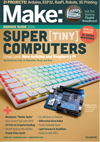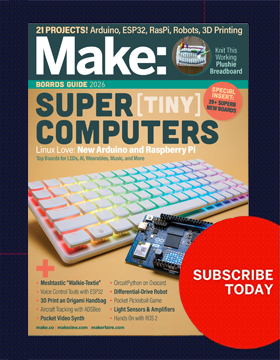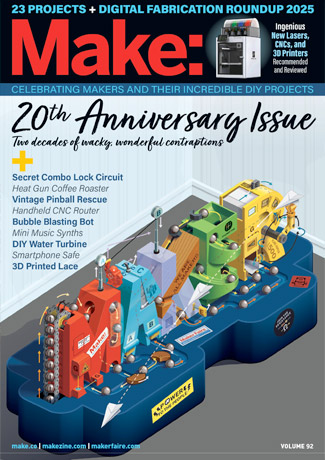

The sale of MakerBot to Stratasys, announced Wednesday, inspired a wide variety of commentary in the technology and Maker communities.
MAKE publisher Dale Dougherty applauded the deal, but highlighted a few issues that could emerge down the road:
“I’m happy for Bre Pettis, his team and his investors. It is a validation of the original vision of MakerBot that there was a consumer market for 3D printing. I proud of its origins as a maker startup. The acquisition does raise some concerns. Will Stratasys actually accelerate the development of personal 3D printers, making them more affordable and easier to use? Will the acquisition hurt the chances of smaller competitors succeeding in this market and making them more vulnerable to patent lawsuits. Overall, though, I want to applaud the acquisition. I hope it leads to new developments that we can’t imagine today.”
Limor “Ladyada” Fried, founder of Adafruit Industries, which sells kits and parts for hardware electronics projects, was enthusiastic about the news.
“The opportunities for makers to start a company, get funding, merge or get acquired are only limited by our desire and imaginations – it’s never been a better time to be a maker. What are you waiting for, go make it! Congrats to Bre, the entire team and the community of makers who have been part of the MakerBot adventure, a new chapter begins.
Analyst Michael Wolf was initially surprised by the $400 million purchase price. On his blog, he wrote:
“Makerbot has very little proprietary technology (after all, its printers are primarily an offshoot of the open source reprap project), hasn’t developed a significant retail channel network in the consumer space (most sales are online) and is already facing significant competition from other lower-priced 3D printing machines from the boatload of new reprap/Kickstarter variants and a much lower-priced entry level system from 3D Systems in the Cube 3D.”
But Wolf added that the deal ultimately made sense for Stratasys, concluding that the company probably felt that “it couldn’t develop its own consumer brand in a market that is moving very fast, and that it probably felt it needed to react quickly before 3D Systems did so with the Cube. They were probably also worried that a big consumer products company like HP jumping into the shallow end (consumer) of the pool and making a big splash as well.”
Wolf also believes that MakerBot’s Thingiverse.com collection is the most valuable part of the MakerBot portfolio.
“The 3D printing services and digital design marketplace is a much bigger potential opportunity in my mind than low-margin 3D printer market,” he wrote.
Ultimately, Wolf concluded, Stratasys “couldn’t take the chance of letting the company with little technology but a lot of brand in the 3D printing space get away.”
Hod Lipson, associate professor of Mechanical & Aerospace Engineering and Computing & Information Science at Cornell University, and the co-author of “Fabricated: The New World of 3D Printing,” said he had “mixed feelings” about the deal.
“On the one hand it’s very exciting because it’s sign of maturity in the field,” he said, comparing it to the 1980s, when many small personal computer companies began consolidating into standardized platforms.
“On the other hand, there’s a loss of diversity. We’ve had many, many small companies trying different ideas, and that’s been exciting. That era could be ending, and that’s bittersweet.”
Hod said that despite MakerBot’s move away from open source model, “open source is still alive and well. There are still many options for people who want to modify and experiment with 3D printers.”
Adrian Bowyer, who invented the RepRap model that provided the foundation for MakerBot, said he was “obviously pleased” with the recent $400+ million purchase of MakerBot by Stratasys because he owns a small percentage of MakerBot, the company.
Otherwise, he said, the deal will have little impact on the RepRap movement, “which is still going along pretty well.”
MakerBot began as an open source RepRap project. Over the last few years, however, it has added proprietary technology. As a result, MakerBot has alienated some of its earliest advocates.
Not Bowyer.
Reached via cell phone on a train bound for Cambridge, England from his home in Bath, Bowyer said he’s “not really much good at the business side of things.”
“MakerBot not being open source, that never bothered me,” he said.
His passion: creating manufacturing machines that have the ability to reproduce themselves.
By that measure, MakerBot is no longer as interesting to him, despite its financial success.
“RepRap is about self-replication,” he said. “RepRap is open source because that strategy will out-compete closed-source systems in reproductive fitness. Every RepRap can make RepRaps.”
By contrast proprietary 3D printers, such as a MakerBot, can make RepRaps. But RepRap printers can’t make any of them.
“The more 3D printers that are out there — of all kinds — the more RepRap printers that will be created. So I’m all in favor of 3D printers of all types.”
“When it comes to the success or failure of RepRap,” Bowyer added, “money is almost completely irrelevant. It is the evolutionary game theory that matters.”
ADVERTISEMENT





